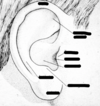External ear Flashcards
(23 cards)
What is it made up of?
Pinna and external auditory meatus
what is the ear lobe composed of?
-Ear lobe- does not contain cartilage, only fibrous tissue, fat and blood vessels -Tragus: long projection which covers the EAM
how long is External acoustic meatus and what is it made up of?
-4cm long in adults -First 1/3rd is cartilage and skin -Medial 2/3rds made up of skin and bone
Differences between medial and lateral portions of the EAM
Medial: -No wax -No glands Lateral: -Sebacous and cerous glans which produce wax -thick hairs which get thinner as you enter more
Timpanic membrane function
Separates the EAM from the middle ear
What are the different sections of the timpanic membrane made up of?
3 layers: outside layer continues with EAM- same epithelium Middle: fibrous Internal: Respiratory epithelium
What type of epithelium is respiratory epithelium?
Ciliated columnar with goblet cells
How does the timpanic membrane move?
In response to air vibrations
Parts of the timpanic membrane to remember?
-Umbo: Peak of depression -Manubrium of malleus: One of the tiny bones involved in the transfer of sound -Cone of light -Pars tensa -Pars flaccida
Middle ear sections?
Timpanic cavity: directly behind the timpanic membrane Epitympanic recess: space surrounding the tympanic membrane
Epithelium of the middle ear
Ciliated columnar with goblet cells
Important structure of the middle ear
- Facial nerve passes through it (fibres of the chorda timpani)
- Eustacian tube connects it to the aditus and the nasopharyx
Which structures are closely affiliated with the Middle ear?
-Internal carotid -Middle cranial fossa -Internal jugular vein -Sigmuid sinus
Which are the 6 segments of the facial nerve?
-Intracranial -Meatal -Labyrinthine -Tympanic -Mastoid -Extratemporal
What is the function of the UMBO in the tympanic membrane ?
It creates new epithelium in the external ear. Epithelium is constantly shred and renewed. The remnant is trapped and kept in the lateral 1/3rd of the ear
What is the pinna made up of?
thin elastic cartilage covered in a thin layer of keratinised epithelium
What are the depressions and elevations of the pinna called?
Depressions:Concha Elevations: helix
Dimensions of the tympanic membrane
-Grey and transluscent -1cm in diameter -1/10mm thick




Which muscles are connected to the eustacian tube?
Tensor veli palatini
Levator veli palatini
How does the eustacian tube control pressure in the middle ear
Through the tensor veli palatini and the the levator veli palatini
Where does the eustacian tube open up in the nasopharynx?
In the inferior meatus


